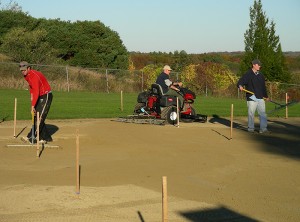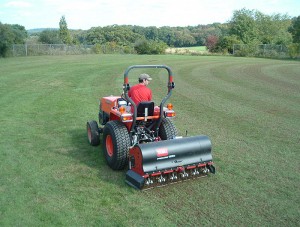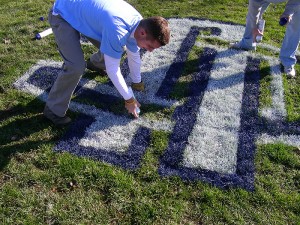
A new course in athletic field management is now offered in the College of Agriculture and Natural Resources.
The course addresses specific cultural practices and strategies associated with heavily used athletic fields, such as mowing, fertilization, irrigation, core cultivation, overseeding, and pest control. Other topics include surface renovation, optimizing wear tolerance, maximizing turfgrass recovery, traffic management, game day preparations, and logo painting.
“I believe this is the only course of this type being taught in turf programs in New England,” says Jason Henderson, an assistant professor in the Department of Plant Science and Landscape Architecture.
In addition to two- and four-year undergraduate students, Henderson says he hopes the course will also draw people from the industry.
Guest lecturers provide information on a variety of issues related to sports turf management, including communication strategies for coaches, athletic field liability issues, and sport field specifics in football, baseball, and tennis.
Beginning with the first class last fall, students experienced a hands-on renovation of the softball field behind the W.B. Young building. The work progressed throughout the semester, beginning with an initial assessment and continuing with a prepared renovation plan that included turf and weed identification and recommendations for control; infield and outfield soil test samples and assessing soil texture and nutrients; fertility and weed control strategies; adjustments in mowing frequency and mowing height; core cultivation in preparation for seeding; and overseeding with selected turf species.

By mid-October, the turf was much improved, and the class turned their focus to renovating the infield, which included a demonstration on the use of a dual-slope laser to prepare the infield for grading; adding 60 tons of infield material; and leveling, compacting, smoothing, and raking.
Henderson says the class went outside and observed the renovation as the course progressed. “You can sit in a class all day and talk,” he says, “but it’s important to get out in the field and set up the equipment and have the students actually set a benchmark and determine the slope of the field. It’s more fun to teach this way.”
Turf management major Kyle Carney says, “The class allowed me to learn athletic field management concepts in the classroom and then physically apply what I had just learned.”
With the field now in much better condition, this fall’s class will focus on drainage and topdressing. Once the renovation is complete, students will implement typically required field maintenance.
“Dr. Henderson’s class was a very interesting and hands-on class,” says Robert Deasy, a turfgrass and soil science major. “I learned a great deal through his excellent lectures, guest speakers, and our own personal work in the field. I looked forward to every class.”

Henderson says the class is made possible by donations and assistance from the University and members of the turf industry.
Turf Products Corp. of Enfield, a Toro distributor, made mowing equipment available; Chas. C. Hart Seed Company in Wethersfield donated turf seed and infield conditioner; Mike Flowers of Championship Turf Services in Harwinton donated the use of a dual-slope laser and was a guest lecturer; New England Specialty Soils of Lancaster, Massachusetts, donated infield material; and World Class Athletic Surfaces of Leland, Miss., donated turf paint and logos.
Casey Erven from UConn’s athletic grounds department was a guest lecturer and the department provided aeration equipment; the University’s landscape department overseeded the field; and the College of Agriculture and Natural Resources provided funding for equipment.
Other guest lecturers include Tim Burns of the Longwood Cricket Club in Chestnut Hill, Massachusetts; Janet Fink, associate professor in the Department of Kinesiology; Rich Cowles of the Connecticut Agricultural Experiment Station; and John Kaminski, formerly a faculty member in the Department of Plant Science.


